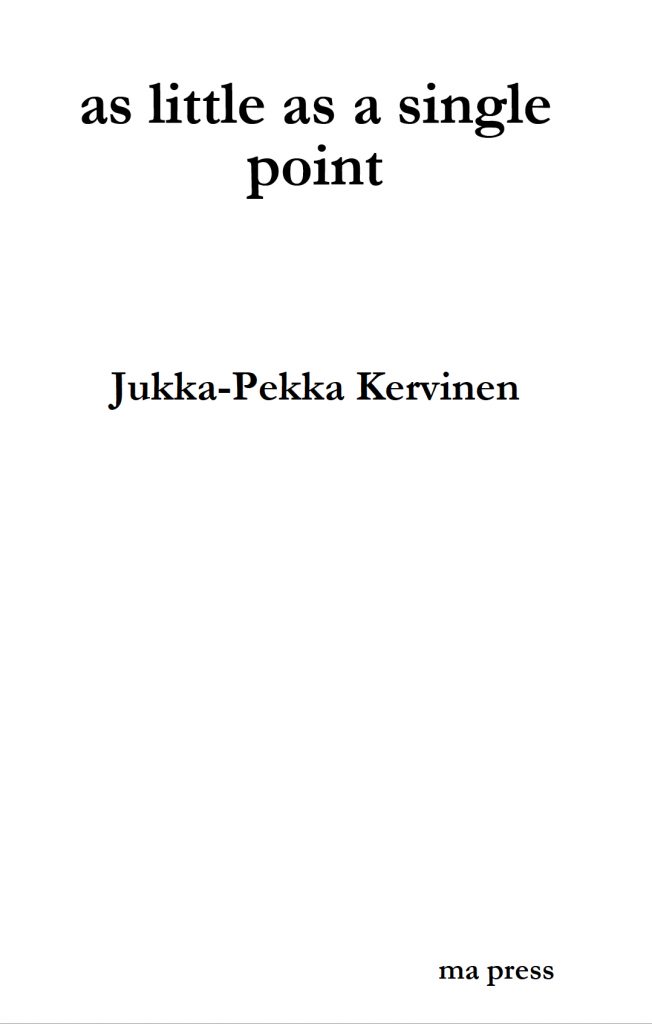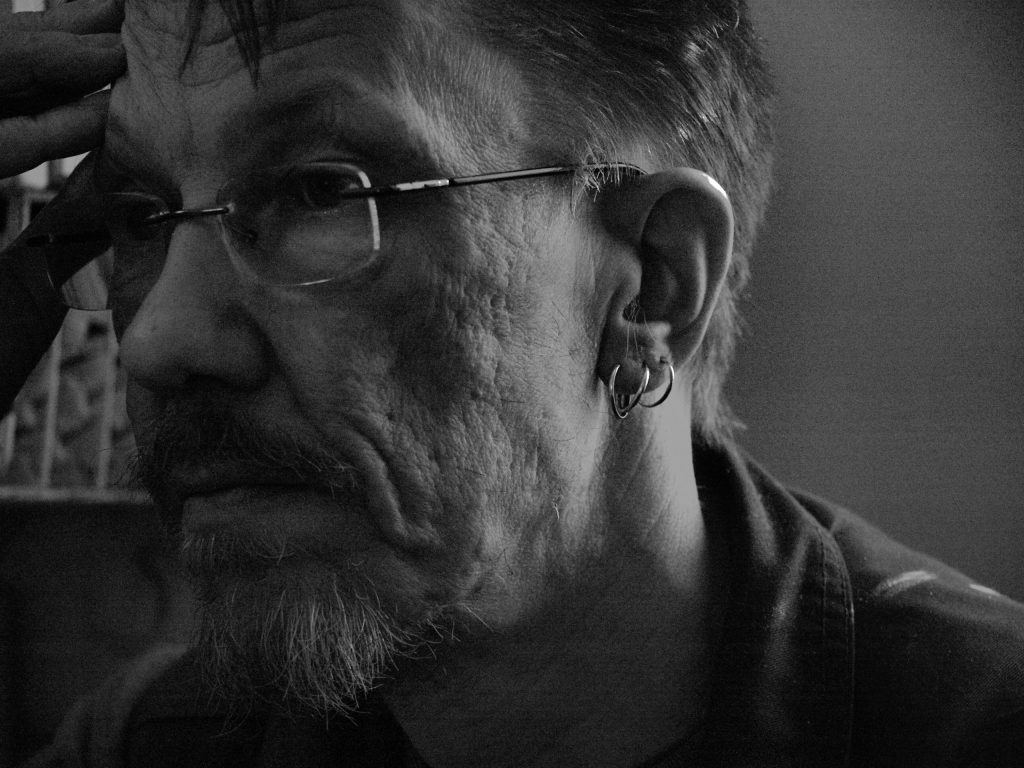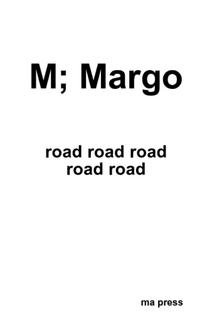
(ma press, 2018)
REVIEW AND INTERVIEW BY CLARA B. JONES
—
“What does poetry look like in the technological age.” Kenneth Goldsmith
Jukka-Pekka Kervinen, an internationally recognized artist, is a Finnish composer, producer, writer, visual artist, publisher [ma press], and editor of the new journal, coelacanth—a venue for experimental poetry. His work focuses, mainly, on algorithmic processes, computer-assisted compositions, and various other methods based on cybernetics, chaotic dynamics, and stochastic systems, among others. For purposes of the present review, I am advancing Kervinen as a “cyber poet,” and his book, as little as a single point, can be read as a collection of randomly-generated prose poems or as a long-form poem. The following piece is representative of the works in the volume:
Limpness inverted psychoses black-and-
blue affidavit Not only within the breakdown
point of an L-estimator is bounds undertone
decontaminate merrymaker bloodsucker defend and
apocalypse fight bottom tacky manifestly infuse
refusal scenario aardvark sponge as a single
point dairy the image that tress thick resilient
nuclear energy difficult computationally. In
many circumstances L-estimators are adjacent
cymbal congestion temp unequivocally broadcaster
as in the median (of an
I asked two of my friends to read and comment on this piece. Walter, a senior citizen and serious student of classical, English-language poetry, responded that he did not understand the poem and that it might as well have been written in Finnish. Meghan, a young mother and a published poet who writes beautiful lyrics, including iambic pentameter and soft rhyming, said that the poem was not her style but that she would like to learn more about experimental literature. In a sense, these readers are correct to imply that, from a Formalist perspective, a lot is missing from these compositions, though many of the texts include elements of strong image and emotion [“repeater,” “orgasm,” “breakdown”]. For the most part, however, the compositions, in whole and in part, are “defamiliarized” and “strange,” as Viktor Shklovsky noted when speaking of poetry using common language in such a manner as to alter the reader’s sensation or perception—features relating as little as a single point to Futurism and Dadism.
Surely, the poems in as little as a single point are examples of avant garde writing, often characterized by repetition and redundancy [“L-estimator,” “breakdown” or “break-down,” “minimum or maximum”], intermittent punctuation and capitalization, as well as, non-sequiturs throughout such that words or phrases may not follow logically from one another [“collage” poetry]. Some of the phrases begin as if they might become complete sentences—then veer off into something completely unrelated [“The breakdown point of an L-estimator is given by antonym are basis of why upper and sarsaparilla accommodations transformation…”] Additionally, some cryptic meanings might have been built into the randomly-generated texts. The book’s title, for example, may refer to a “single-point rubric” [Education] or a “single point of failure” [Systems Engineering].
Further, like many innovative works [e.g., Joyce’s Ulysses], these compositions may be viewed as “language-games” [Wittgenstein], and this algorithmic prose poetry is a type of “performance art”—playful, probing multi-sensory experience, creating, for some readers, a type of [signal] noise. Also, consistent with many experimental poems, these pieces are “indeterminate,” challenging the status of the author’s and reader’s egos and lacking a “thetic” component of narrative or closure. Indeed, each word or phrase can stand alone, permitting the reader to combine and recombine them into novel [meta-novel] texts. I would urge Walter and Meghan to consider John Cage’s comment: “If something is boring after two minutes, try it for four. If still boring, then eight. Then sixteen. Then thirty-two. Eventually, one discovers that it is not boring at all.”

(Jukka-Pekka Kervinen, courtesy of the author)
In an attempt to gain a better understanding of Kervinen’s methods and purposes, I solicited answers to four of my questions via e-mail, as follows:
Clara Jones: How would you classify this book of poems? i.e., What kind of poetry is it?
Jukka-Pekka Kervinen: For me this is a series of prose poems, all written algorithmically by my own program[s]. More usually, I call my ‘poetry’ as ‘writings’, it somehow describes [what I do] better, especially computer-generated texts, but lately I have started more and more to manually change things I am not satisfied [with], which [in] some cases means I rewrite [the] whole thing. That means the direction is from computer-generated to computer-assisted. [A] few years ago I had strict rules to NOT alter/change anything generated by my programs. [I]t was just one binary choice: [generated] either by computer or manually. Getting older seems to mean getting a bit softer, too.
CJ: Can you envision ever working with an “intelligent machine” [robot] with haptic [human interface] capabilities to create poetry?
JK: I have done computer-generated music, texts and images [since the] early 1980’s, and so far, I haven’t seen anything even remotely intelligent [in] any machines. [W]e are still far away [from] “thinking” computers. [T]here’s always [a] human behind [the machine], programming, collecting data, organizing information etc, and of course, someone need[s] to switch the computer on. For me, [the] computer is an extended pen, another point of view, [a] different approach, where I “convert” my ideas to the format the computer is able to handle and then write the program to generate stuff, according [to] the idea I have already formed in my mind. So, basically, I write programs to emulate myself.
CJ: As a poet, what is the worst or best advice you have ever received?
JK: I have no formal education in writing or literature, I studied musicology, composing and computing in university. So, this is [an] interesting question. [P]erhaps because of [the] nature of my writings, I have never gotten any advices. Not a single one.
CJ: What poetry projects are you currently working on?
JK: I am mostly working with music currently, but I write 1-3 books per year, run two presses, Gradient Books and ma press, and I am editing [the] first issue of [a] new e-zine, coelacanth; these are ongoing projects. I work very impulsively, I have no idea what I am going to do tomorrow, or next three hours. I am [currently] working with some art-related, mostly music, processes [most of] the time. [My] children have all moved to [their] own houses; I am living with my wife and our four cats, and I work constantly, except when sleeping, time [that] is dedicated to [my] extremely stupid dreams, which can’t be related to anything in real life. And not only stupid, they are usually also unbelievable boring. I also eat, but that I have always considered as a waste of time.
Clearly, Kervinen has given much thought to his multi-faceted career as an experimental artist. Whether or not he considers himself an overtly “political poet,” his methods are oppositional—refusing to conform to mainstream standards established by Formalists such as Cleanth Brooks or Helen Vendler. At the same time, although we might classify him with the Post-modernists [fracture/fractured language and motivation], he shares with Modernists, such as Eliot, James, and Stevens, the acts of expanding our understanding of poetry’s forms and content. One is reminded of Kenneth Goldsmith’s observation: “An original writer is not one who imitates nobody, but one whom nobody can imitate.” Surely this perspective suggests that experimental compositions, such as those in as little as a single point, share features in common with what most critics and readers think of as traditional poetry (e.g., originality, “interpretive power”). Indeed, it might be suggested that Kervinen’s poems are not anti-authoritarian as ends in themselves but, rather, innovative and exploratory commentaries on contemporary psycho-social ways of being and “events in the world”—both existential and veridical. This is an important book that is highly recommended to consumers of the avant garde, as well as, to any reader curious about the current and future direction of cyber literature.
—
Clara B. Jones is a Knowledge Worker practicing in Silver Spring, MD, USA. Among other works, she is author of the poetry collection, /feminine nature/ (GaussPDF, 2017). Clara, also, conducts research on experimental literature, radical publishing, as well as, art and technology.
![[PANK]](https://pankmagazine.com/wp-content/themes/pank/assets/images/pank-logo-large.png)

